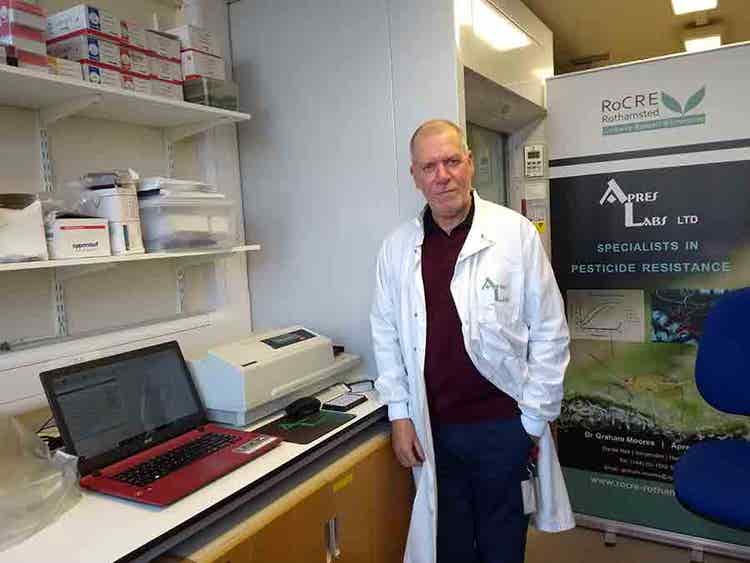
ApresLabs use SpectraMax readers to revolutionize research into pesticide resistance
COMPANY/UNIVERSITY
ApresLabs
TEAM MEMBERS
Dr. Graham Moores
PRODUCTS USED
Gemini EM Microplate Reader
The Challenge
Resistance to insecticides is a major obstacle to controlling insect pests in a sustainable manner in the agricultural industry. Aware of this issue, Dr Graham Moores founded ApresLabs Ltd in the UK in 2012, with the aim of helping agri-biotech companies to maximise the commercial life of their products. Dr. Moores has investigated the biochemical basis of insecticide resistance for over 40 years and has become a leading authority on the subject. Being one of very few biochemists working in this area, he has often presented at international and national events, written for popular journals and appeared on TV and radio.
We asked Dr. Moores to tell us more about his research, and its impact on the agricultural industry…
“Whilst there are ongoing initiatives to develop alternative strategies, synthetic insecticides will almost certainly remain the main method for the control of agricultural insect pests for many years.

There is also, however, increased awareness of the negative issues arising as a result of prolonged or excessive insecticide usage, including environmental damage, pollinator poisoning and insecticide resistance. The withdrawal of older chemistries together with the decline in the discovery rate of novel insecticidal molecules is also creating difficulties in pest management in some instances.
Insecticide synergists inhibit the metabolic defence of insects, overcoming resistance and potentially allowing lower rates of insecticide to control pests. Synergists have not yet achieved large scale use in field agriculture, but a quasi-synthetic synergist (piperonyl butoxide) is widely used in public health products such as those used for house fly control.
To maximise the ecological benefits of using a synergist, the product would need to be at least as effective as piperonyl butoxide in overcoming insect pests’ two major metabolic enzyme systems (P450s and esterases) as well as being both pollinator- and environmentally- friendly”.
In order to identify such synergists, the team at ApresLabs needed to be able to measure the enzyme activities of P450s and esterases, in the presence/ absence of putative inhibitors, in a high-throughput microtitre plate-based system.
The Solution
Dr. Moores has used Molecular Devices microplate readers for over 40 years, so when setting up ApresLabs he wanted a system that he knew and trusted. The team use a number of our microplate readers, including the SpectraMax Gemini EM Microplate Reader for fluorescence detection, to create a high-throughput system to identify potential candidates for insecticide synergists.

Gemini XPS and EM Microplate Readers
Instrument used
The SpectraMax Gemini EM Microplate Reader provides a flexible environment to determine the optimal excitation and emission settings for most fluorescent intensity assays. As a dual-monochromator spectrofluorometer system, it allows researchers to try new and novel dyes without having to purchase extra filter sets.
SoftMax Pro Microplate Data Acquisition and Analysis Software, which provides convenient data analysis without exporting to another spreadsheet software, is included with every Gemini EM Reader. Software validation, IQ/OQ/PQ and FDA 21 CFR Part 11 compliance tools are also available.
The Results
The team at ApresLabs studied the interaction of different analogues of piperonyl butoxide with the metabolic enzymes FE4 and CYP6CY3 of the green peach aphid Myzus Persicae, which is known to have insecticide-resistance. Structure–activity relationship (SAR) analyses were performed and several candidate synergists identified which have high inhibitory potency. These are currently the focus of a patent application.
Dr. Moores says, “I have used Molecular Devices kinetic plate readers since my Biochemistry Lab in Rothamsted Research gained a SpectraMax VersaMax in the late 1980s (I think one of the first in the country); I like their versatility and the integrated SoftMax Pro software is second to none”.
More information
The interactions of piperonyl butoxide and analogues with the metabolic enzymes FE4 and CYP6CY3 of the green peach aphid Myzus Persicae (Hemiptera: Aphididae).
Panini et al. Pest Man Sci 73(2) 371-379 (2016)